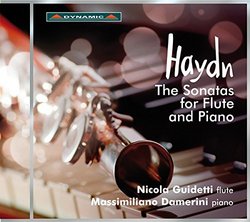| All Artists: Nicola Guidetti, Massimiliano Damerini Title: Haydn: The Sonatas for Flute and Piano Members Wishing: 0 Total Copies: 0 Label: Dynamic Release Date: 7/29/2014 Genre: Classical Style: Chamber Music Number of Discs: 1 SwapaCD Credits: 1 |
Search - Nicola Guidetti, Massimiliano Damerini :: Haydn: The Sonatas for Flute and Piano
 | Nicola Guidetti, Massimiliano Damerini Haydn: The Sonatas for Flute and Piano Genre: Classical The enormous success of Haydns last Quartets has few equals in late 18th-century chamber music. It is from these last collections of works that the Kantor of Leipzigs famous Thomaskirche August Eberhard Müller (North... more » |
Larger Image |
CD Details
Synopsis
Product Description
The enormous success of Haydns last Quartets has few equals in late 18th-century chamber music. It is from these last collections of works that the Kantor of Leipzigs famous Thomaskirche August Eberhard Müller (Northeim, 1767 - Weimar, 1817) adapted for flute and piano three of Haydns Quartets, publishing them with Breitkopf and Härtel as Sonatas Op. 87 and Op. 90 Nos. 1 and 2. The Sonata in C Major Op. 87, published by Müller in 1797, is based on the Quartet Op. 74 No. 1; the two Sonatas Op. 90, published in 1803, are instead taken from the Quartet Op. 76 No. 6 and Quartet Op. 77 No. 1. The Sonatas always keep the same tonality as the Quartets from which they derive, but their structure is in three movements instead of four, with the suitable suppression of the Minuet. Müller was an experienced and skilled musician, who regularly collaborated with Breitkopf and Härtel both as composer and as arranger. It is not surprising, therefore, that the three Sonatas, which at the time were published as original Haydn works, without Müller being mentioned at all, show a treatment of the flute and piano that is virtually equal and concertante, developed with great expertise (Müller, incidentally, was an excellent flautist). But then the musical invention is that of the best Haydn, the Haydn of the Quartets. The result is three compositions in which it is impossible not to admire that mix of simplicity and subtle writing complexity that has always been the most characteristic trait of Haydns artistry; an artistry that is revealed not so much in the lyricism of slow movements, for which Haydn had no particular inclination, as in the masterful sonata structure of opening movements and in the characteristic good-humoured mood of final ones, often imbued with subtle, gentle humour.
